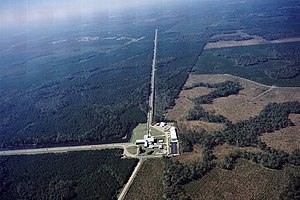Portal:Radiation astronomy/Resource/34
Gravitationals
[edit | edit source]


Gravitational radiation appears to be cylindrical waves of radiation produced by relativistic, undulatory gravitational fields in Euclidean space.[1]
| Interaction | Mediator | Relative Magnitude | Behavior | Range |
|---|---|---|---|---|
| Strong interaction | gluon | 1038 | 1 | 10−15 m |
| Electromagnetic interaction | photon | 1036 | 1/r2 | universal |
| Weak interaction | W and Z bosons | 1025 | 1/r5 to 1/r7 | 10−16 m |
| Gravitational interaction | photon or graviton ? | 10 | 1/r2 | universal |
As the gravitational interaction is 10-36 that of the electromagnetic interaction to produce gravitational radiation requires a massive oscillator.
At right are the results from the first gravitational radiation detection. The images show the radiation signals received by the Laser Interferometer Gravitational Observatory (LIGO) instruments at Hanford, Washington (left) and Livingston, Louisiana (right) and comparisons of these signals to the signals expected due to a black hole merger event.
The wavelength of the gravitational waves is given by for example: 3 x 108 m‧s-1/400 Hz = 750,000 m, which is way longer than radio waves but expected for such a weak oscillator. 35 Hz corresponds to 8,600,000 m.
LIGO operates two detectors located 3000 km (1800 miles) apart: One in eastern Washington near Hanford, and the other near Livingston, Louisiana. The photo on the left shows the Livingston detector.
"According to general relativity, a pair of black holes orbiting around each other lose energy through the emission of gravitational waves, causing them to gradually approach each other over billions of years, and then much more quickly in the final minutes. During the final fraction of a second, the two black holes collide at nearly half the speed of light and form a single, more massive black hole, converting a portion of the combined black holes' mass to energy, according to Einstein's formula E=mc2. This energy is emitted as a final strong burst of gravitational waves. These are the gravitational waves that LIGO observed."[2]
"LIGO’s twin interferometers bounce laser beams between mirrors at the opposite ends of 4-kilometre-long vacuum pipes that are set perpendicularly to each other. A gravitational wave passing through will alter the length of one of the arms, causing the laser beams to shift slightly out of sync."[3]
Later detection confirmed the fusion of two massive stellar-sized objects, a binary neutron star merger.[4]
"According to Einstein's field equations, photon matter subject to quadruple oscillations is a source of gravitational waves."[5]
"In this work, we present a solution to the first stage of a new two-stage global treatment of the vacuum binary black hole problem [1, 2]. The approach, based upon characteristic evolution, has been carried out in the regime of Schwarzschild perturbations where advanced and retarded solutions of the linearized problem can be rigorously identified [3]. Computational experiments are necessary to study the applicability of the approach to the nonlinear regime. From a time-reversed viewpoint, this first stage is equivalent to the determination of the outgoing radiation emitted from the fission of a white hole in the absence of ingoing radiation. This provides the physically correct “retarded” waveform for a white hole fission, were such events to occur in the universe. Although there is no standard astrophysical mechanism for producing white holes from a nonsingular matter distribution, white holes of primordial or quantum gravitational origin cannot be ruled out."[6]
"This fission problem has a simpler formulation as a characteristic initial value problem than the black hole merger problem. The boundary of the (conformally compactified) exterior spacetime contains two null hypersurfaces where boundary conditions must be satisfied: past null infinity I−, where the incoming radiation must vanish, and the white hole event horizon H−, which must describe a white hole, which is initially in equilibrium with no ingoing radiation and then distorts and ultimately fissions into two white holes with the emission of outgoing gravitational waves."[6]
An almost identical signal could originate from a comparable much more massive neutron star fission.
"This is an exciting time to study gravitation, astrophysics and cosmology. Through challenging cosmic microwave background (CMB) and supernovae observations cosmology has been turned on its head. Gravitational radiation astronomy should be the next contributor to this revolution in astrophysics and cosmology."[7]
References
[edit | edit source]- ↑ A. Einstein and N. Rosen (January 1937). "On gravitational waves". Journal of the Franklin Institute 223 (1): 43-54. doi:10.1016/S0016-0032(37)90583-0. http://www.sciencedirect.com/science/article/pii/S0016003237905830?via%3Dihub. Retrieved 2018-1-03.
- ↑ Ivy F. Kupec (11 February 2016). Gravitational waves detected 100 years after Einstein's prediction. Alexandria, Virginia, USA: National Science Foundation. pp. 1. https://www.nsf.gov/news/news_summ.jsp?cntn_id=137628. Retrieved 2018-01-03.
- ↑ Davide Castelvecchi & Alexandra Witze (11 February 2016). "Einstein's gravitational waves found at last LIGO 'hears' space-time ripples produced by black-hole collision". Nature. doi:10.1038/nature.2016.19361. http://www.nature.com/news/einstein-s-gravitational-waves-found-at-last-1.19361. Retrieved 2018-01-03.
- ↑ B. P. Abbott, the LIGO Scientific Collaboration]] & the Virgo Collaboration (16 October 2017). "GW170817: Observation of Gravitational Waves from a Binary Neutron Star Inspiral". Physical Review Letters 119 (16). doi:10.1103/PhysRevLett.119.161101.
- ↑ Constantin Sandu and Dan Brasoveanu. Sonic Electromagnetic Gravitational Spacecraft, Part - Principles, In: AIAA SPACE 2007 Conference & Exposition. AIAA 2007-6203. American Institute of Aeronautics and Astronautics. https://arc.aiaa.org/doi/abs/10.2514/6.2007-6203. Retrieved 2018-01-10.
- ↑ 6.0 6.1 Roberto Gómez, Sascha Husa, Luis Lehner, and Jeffrey Winicour (15 September 2002). "Gravitational waves from a fissioning white hole". Physical Review D 66 (6): 1-9. doi:10.1103/PhysRevD.66.064019. https://arxiv.org/pdf/gr-qc/0205038. Retrieved 2018-01-10.
- ↑ Nelson Christensen, Renate Meyer and Adam Libson (1 December 2003). "A Metropolis–Hastings routine for estimating parameters from compact binary inspiral events with laser interferometric gravitational radiation data". Classical and Quantum Gravity 21 (1): 317-330. doi:10.1088/0264-9381/21/1/023. http://people.carleton.edu/~nchriste/CQG03.pdf. Retrieved 2018-1-19.
